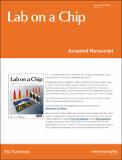| dc.contributor.author | Zhang, Ce | |
| dc.contributor.author | Jiang, Kai | |
| dc.contributor.author | Liu, Fan | |
| dc.contributor.author | Doyle, Patrick S. | |
| dc.contributor.author | van Kan, Jeroen A. | |
| dc.contributor.author | van der Maarel, Johan R. C. | |
| dc.date.accessioned | 2014-11-03T15:17:04Z | |
| dc.date.available | 2014-11-03T15:17:04Z | |
| dc.date.issued | 2013-04 | |
| dc.date.submitted | 2013-02 | |
| dc.identifier.issn | 1473-0197 | |
| dc.identifier.issn | 1473-0189 | |
| dc.identifier.uri | http://hdl.handle.net/1721.1/91270 | |
| dc.description.abstract | We report an approach to study the in situ conformational response of single biomolecules such as DNA to a change in environmental solution conditions. These conditions are, for example, the composition of the buffer or the presence of protein. For this purpose, we designed and fabricated a nanofluidic device featuring two arrays of parallel nanochannels in a perpendicular configuration. The cross-sections of the channels are rectangular with a diameter down to 175 nm. These lab-on-a-chip devices were made of polydimethylsiloxane (PDMS) cast on a high quality master stamp, obtained by proton beam writing and UV lithography. Biomolecules can be inserted into the device through the array of channels in one direction, whereas the buffer can be exchanged through the intersecting array of channels in the other direction. A buffer exchange time inside the grid of nanochannels of less than one second was measured by monitoring the conductivity of salt solutions. The exchange time of a protein was typically a few seconds, as determined by imaging the influx of fluorescence labelled protamine. We demonstrate the functionality of the device by investigating the compaction of DNA by protamine and the unpacking of pre-compacted DNA through an increase in the concentration of salt. | en_US |
| dc.description.sponsorship | Singapore-MIT Alliance for Research and Technology | en_US |
| dc.description.sponsorship | Singapore. Ministry of Education (Grant R-144-000-270-112) | en_US |
| dc.description.sponsorship | Singapore. Ministry of Education (Grant R-144-000-312-112) | en_US |
| dc.description.sponsorship | National Science Foundation (U.S.) (Grant CBET-0852235) | en_US |
| dc.language.iso | en_US | |
| dc.publisher | Royal Society of Chemistry, The | en_US |
| dc.relation.isversionof | http://dx.doi.org/10.1039/c3lc50233c | en_US |
| dc.rights | Creative Commons Attribution-Noncommercial-Share Alike | en_US |
| dc.rights.uri | http://creativecommons.org/licenses/by-nc-sa/4.0/ | en_US |
| dc.source | MIT web domain | en_US |
| dc.title | A nanofluidic device for single molecule studies with in situ control of environmental solution conditions | en_US |
| dc.type | Article | en_US |
| dc.identifier.citation | Zhang, Ce, Kai Jiang, Fan Liu, Patrick S. Doyle, Jeroen A. van Kan, and Johan R. C. van der Maarel. “A Nanofluidic Device for Single Molecule Studies with in Situ Control of Environmental Solution Conditions.” Lab Chip 13, no. 14 (2013): 2821. | en_US |
| dc.contributor.department | Massachusetts Institute of Technology. Department of Chemical Engineering | en_US |
| dc.contributor.mitauthor | Doyle, Patrick S. | en_US |
| dc.relation.journal | Lab on a Chip | en_US |
| dc.eprint.version | Author's final manuscript | en_US |
| dc.type.uri | http://purl.org/eprint/type/JournalArticle | en_US |
| eprint.status | http://purl.org/eprint/status/PeerReviewed | en_US |
| dspace.orderedauthors | Zhang, Ce; Jiang, Kai; Liu, Fan; Doyle, Patrick S.; van Kan, Jeroen A.; van der Maarel, Johan R. C. | en_US |
| mit.license | OPEN_ACCESS_POLICY | en_US |
| mit.metadata.status | Complete | |
